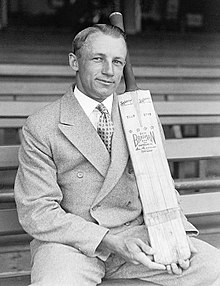
The Fourth Test of the 1948 Ashes series was one of five Tests in a cricket series between Australia and England. The match was played at Headingley Cricket Ground at Leeds from 22 to 27 July with a rest day on 25 July. Australia won the match by seven wickets to take an unassailable 3–0 series lead. In successfully chasing a target of 404, they set a new world record for the highest victorious runchase in Test history, a record lasting until 1976.
Needing to win the match to prevent an Australian series victory, England captain Norman Yardley won the toss and elected to bat. England continued to rearrange their team, making three changes in an attempt to find a combination that could challenge Australia, which made two changes forced by injury. Unlike the preceding Tests, England's openers were able to withstand the Australian new ball attack, and the partnership of Len Hutton and Cyril Washbrook put on 168 for the opening stand. Washbrook fell for 143 in the last over of the day, but England clearly had the better of the play, ending at 268/2 by stumps. Australia's bowlers were heavily criticised for their performance, which was seen as lethargic. The next day, England continued to amass runs, with Australia appearing unthreatening and unable to dislodge Bill Edrich and nightwatchman Alec Bedser, who batted until mid-afternoon. Bedser and Edrich then fell in quick succession for 79 and 111 respectively as England then collapsed and lost 8/73 to be all out for 496 late in the day. The hosts were heavily criticised for the collapse, which was largely due to unforced errors. Among the Australian bowlers, the wickets were shared. Australia then reached 63/1 in reply at stumps on day two.
Australia were in early trouble on the third morning when English bowler Dick Pollard removed Arthur Morris and captain Donald Bradman in the same over to leave the score at 68/3. However, Keith Miller (58) and Neil Harvey (112) launched a rapid counter-attack, adding 121 runs in 90 minutes in a display praised for its aesthetic beauty. They were later supported by Sam Loxton (93)—who hit five sixes—and Ray Lindwall (77), who both struck the ball powerfully. Australia ended the day at 457/9, having added 394 runs in one day, and 102 runs for the last two wickets to that point.
Australia were bowled out for 458 early on the fourth morning after the rest day, and England set about extending their lead, adding 129 for the first wicket, until both openers fell without further addition. In the meantime the workload on the Australian bowlers was heavy as Ernie Toshack had broken down in the first innings and unable to participate further. Edrich and Denis Compton took the score to 232/2 until a late collapse saw England reach stumps at 362/8. England batted on for two overs on the final day, declaring at 365/8. Bill Johnston was the most successful bowler with 4/95. This left Australia a target of 404 in less than a day, which would require a world record runchase, and allowed Yardley to use the heavy roller to break up the pitch, making batting even harder for the tourists. Most observers predicted an easy England win on a deteriorating surface. Australia started slowly, and Bradman joined Morris at 57/1 with 347 runs still needed in 257 minutes. They put together a stand of 301 in only 217 minutes, aided by erratic bowling, several missed catches and stumpings to help Australia to a win by seven wickets with 15 minutes remaining. Morris made 182 while Bradman was unbeaten on 173. The England selectors were heavily criticised after the match for failing to include a leg spinner in the team to exploit the favourable conditions. For the third time in a row, the match set a new record for the highest attendance at a Test in England. Test attendance would never be as high again, as cricket became less popular in the UK.